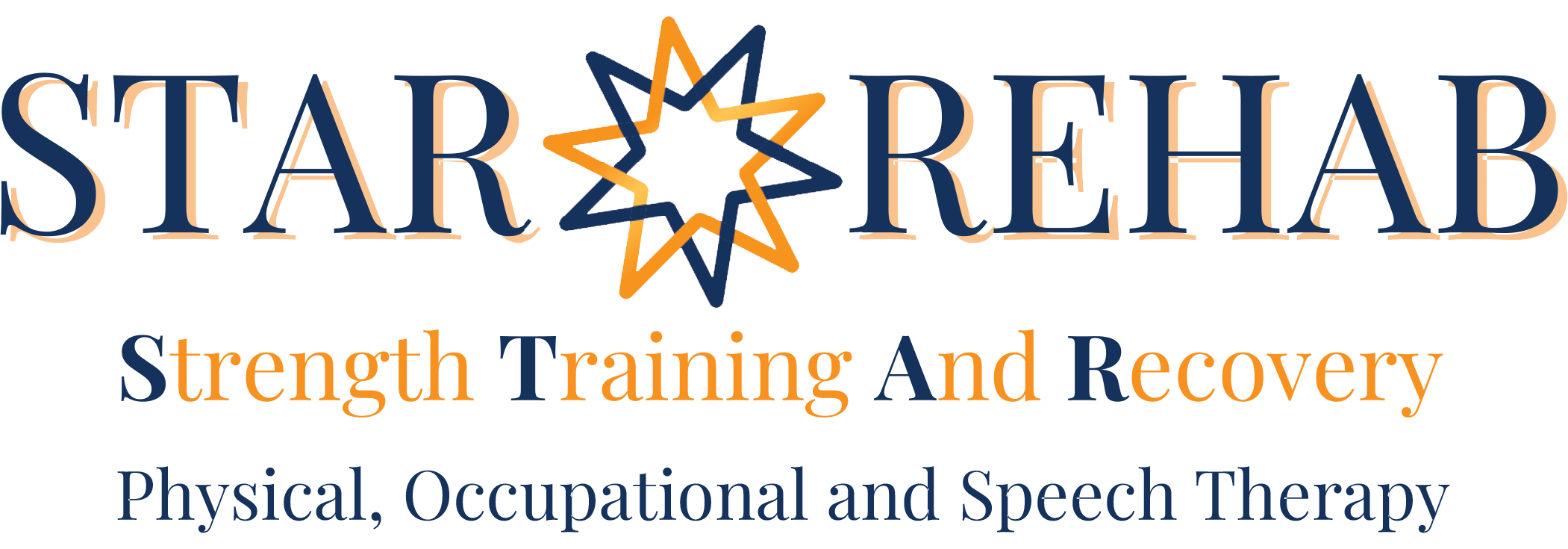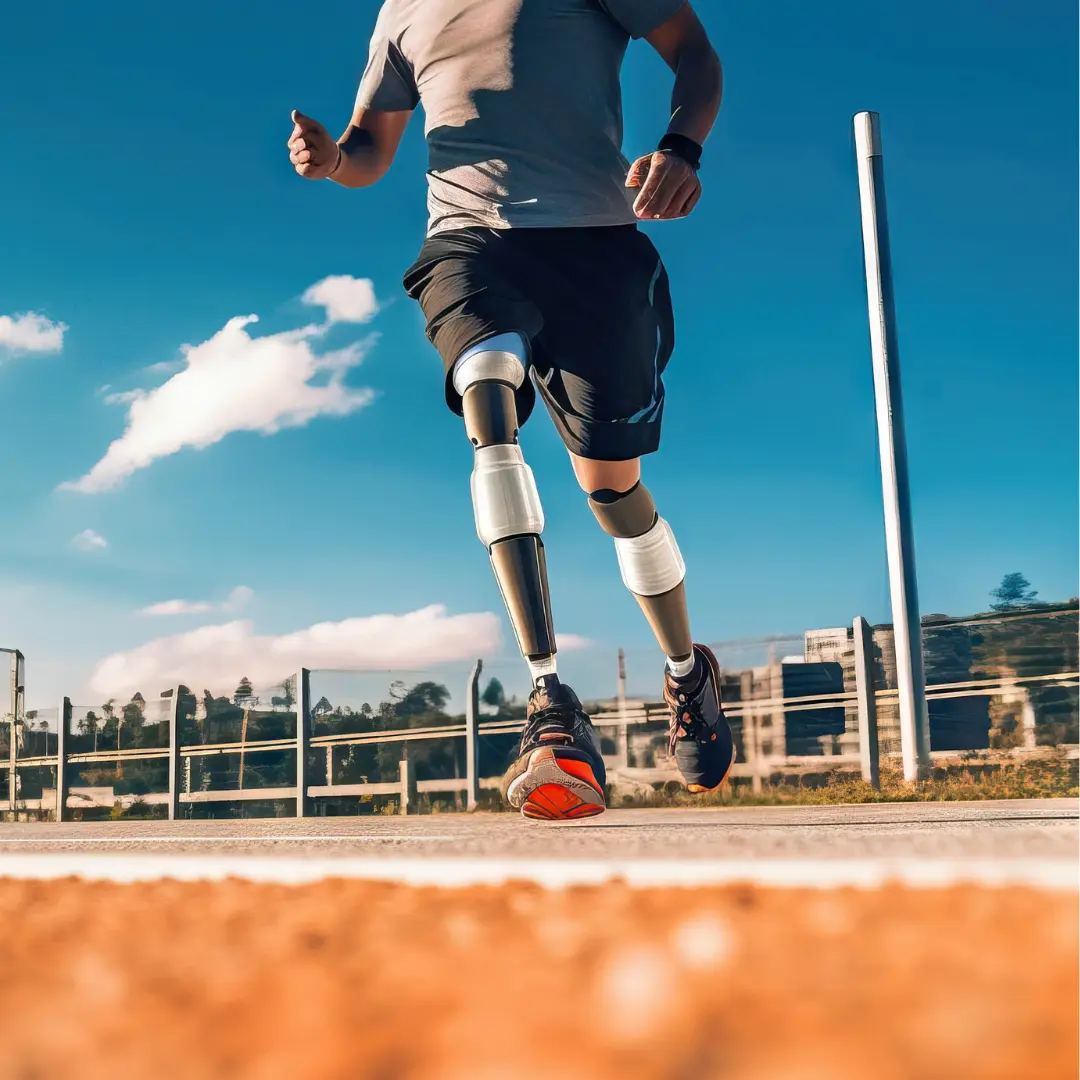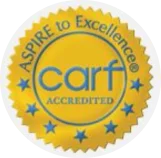Utilizing tailored physical therapy programs tailored for amputees can be instrumental in improving their quality of life. In Flint, Michigan, individuals facing limb loss have access to specialized rehabilitation services aimed at enhancing mobility, strength, and overall well-being. This tutorial will delve into the importance of physical therapy for amputees, exploring specific exercises and techniques that can empower individuals to regain independence and confidence in their daily lives. By understanding the unique needs of amputees and the benefits of targeted therapy, we can pave the way for a brighter and more active future for those navigating the challenges of limb loss.
Key Takeaways:
- Physical therapy is crucial for amputees: Physical therapy plays a vital role in empowering amputees by helping them regain strength, mobility, and independence after amputation.
- Customized treatment plans are essential: Individualized treatment plans are key for amputees as they require specific care tailored to their unique needs, goals, and physical abilities.
- Goal-setting is important for progress: Setting clear and achievable goals with the guidance of physical therapists enables amputees to track their progress, stay motivated, and work towards regaining functionality.
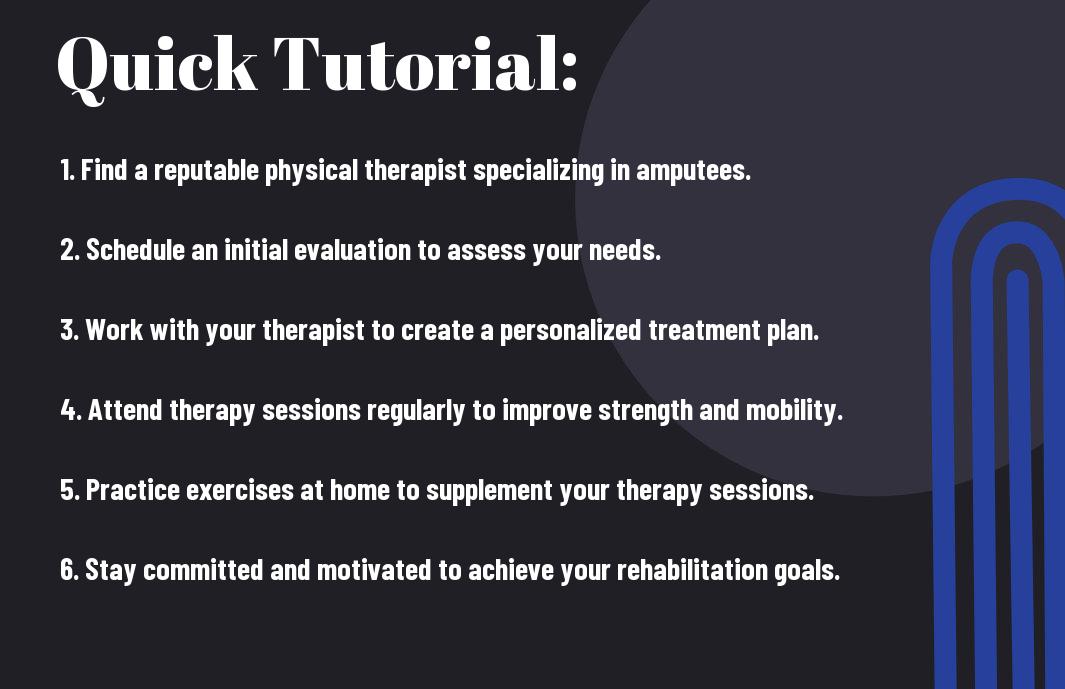
Preparing for Physical Therapy
Some individuals may feel a mix of emotions when preparing for physical therapy after an amputation. It is important to address both the mental and emotional aspects of readiness before beginning treatment. By acknowledging and working through these feelings, patients can better focus on their rehabilitation journey.
Mental and Emotional Readiness
To achieve success in physical therapy, it is crucial for individuals to be mentally prepared for the challenges ahead. This may involve overcoming feelings of fear, uncertainty, or frustration about the process. Seeking support from loved ones, joining a support group, or talking to a mental health professional can help address these emotions. Additionally, practicing relaxation techniques such as deep breathing or visualization can assist in managing stress and anxiety related to therapy.
Setting realistic expectations and maintaining a positive attitude are key components of mental readiness. Understanding that progress may take time and setbacks can occur is essential. By approaching physical therapy with a resilient mindset and a willingness to learn and adapt, individuals can enhance their overall rehabilitation experience.
Setting Realistic Goals
With physical therapy, setting realistic goals is crucial for measuring progress and staying motivated throughout the process. Goals should be specific, measurable, achievable, relevant, and time-bound (SMART). For example, a goal could be to improve balance, increase range of motion, or walk a certain distance with a prosthesis. Discussing these goals with a physical therapist can help tailor a personalized treatment plan that aligns with individual aspirations and abilities.
Setting realistic goals in physical therapy not only provides a sense of direction but also helps track improvements over time. By breaking larger goals into smaller milestones, individuals can celebrate achievements along the way, boosting confidence and momentum. Remember, progress may vary for each person, so it is important to set goals that are challenging yet attainable based on individual circumstances.
Core Components of Physical Therapy for Amputees
Now, let’s delve into the core components of physical therapy that are essential for empowering amputees in Flint, Michigan. By incorporating these key elements into their rehabilitation program, individuals can regain strength, mobility, and independence following limb loss.
Limb Strength and Conditioning
Strength and conditioning exercises play a crucial role in the physical therapy regimen for amputees. By focusing on building muscle strength in the remaining limb and core areas, individuals can improve their overall balance and stability. Additionally, tailored exercises help prevent muscle atrophy and enhance stamina, making daily activities more manageable for the individual.
Physical therapists work closely with amputees to create custom exercise programs that target specific muscle groups, promoting strength and endurance. Incorporating a variety of resistance training, aerobic exercises, and balance drills can help individuals adapt to their new physical capabilities and optimize their functional abilities.
Prosthetic Training and Adaptation
Prosthetic training is a critical component of physical therapy for individuals adjusting to life with limb loss. This phase focuses on familiarizing the individual with their prosthetic device, teaching them how to wear it comfortably, and gradually integrating it into their daily activities. Through guided practice and support, patients can learn how to properly use their prosthesis to improve their mobility and functionality.
Adaptation is a continuous process in prosthetic training, as individuals learn to navigate different terrains, perform various movements, and engage in recreational activities with their prosthetic limb. Physical therapists provide ongoing guidance and support to help patients overcome challenges, build confidence, and maximize their potential with their prosthetic device.
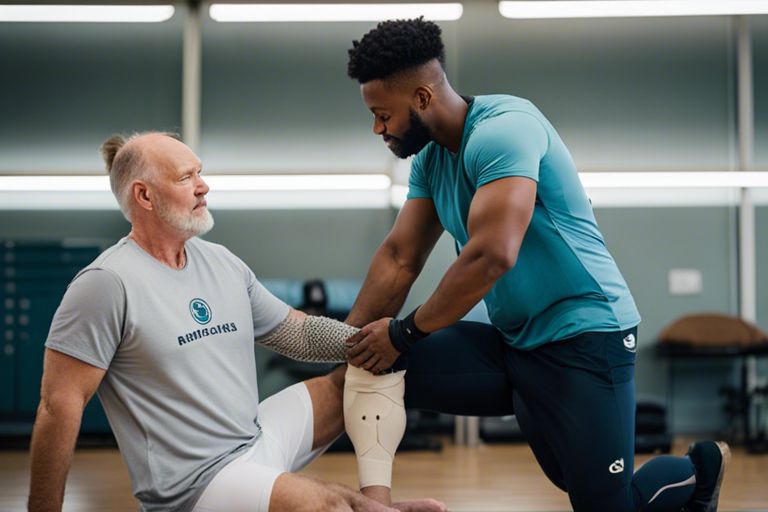
Advanced Physical Therapy Techniques
Keep in mind that advanced physical therapy techniques can make a significant difference in the rehabilitation journey of amputees. These techniques are designed to push the boundaries of recovery and enhance the overall quality of life for individuals facing limb loss.
- Balance and Coordination Exercises
Incorporate stability balls Use balance boards
Practice yoga or Pilates
Focus on proprioception Improve core strength
Enhance coordination skills
Balance and Coordination Exercises
The implementation of balance and coordination exercises is crucial for amputees as it helps them regain their sense of stability and control. These exercises focus on improving proprioception, enhancing core strength, and refining coordination skills, all of which are essential for everyday movements and activities.
Therapists may introduce stability balls, balance boards, and incorporate practices like yoga or Pilates to challenge the individual’s balance and coordination abilities. Through consistent and progressive training, amputees can experience a significant improvement in their overall balance and mobility.
Adaptive Sports and Recreational Activities
With the advancement in prosthetic technology and the availability of adaptive sports programs, individuals with limb loss can now engage in various sports and recreational activities. These activities are not only physically beneficial but also provide a sense of inclusion, empowerment, and social connection for the participants.
To fully benefit from adaptive sports and recreational activities, it is essential for amputees to work closely with their physical therapists to identify suitable options based on their specific abilities and goals. Whether it’s swimming, cycling, running, or even more challenging pursuits like rock climbing or skiing, there is a wide range of options available to cater to different interests and fitness levels.
Community and Support Resources
Your journey towards empowerment as an amputee in Flint, MI is not one you have to take alone. There are various community resources and support networks available to assist you in navigating your new normal and achieving your physical therapy goals.
Local Support Groups and Organizations
The Flint community offers a range of support groups and organizations specifically tailored to individuals who have undergone an amputation. These groups provide a safe space for sharing experiences, seeking advice, and receiving emotional support from others who understand the challenges you may be facing. Connecting with these groups can help you feel less isolated and more empowered in your journey towards rehabilitation.
Support organizations like the Amputee Support Team of Michigan and local chapters of national organizations such as the Amputee Coalition can provide valuable resources, peer mentoring, and educational opportunities to help you navigate life post-amputation. These groups often host events, workshops, and informational sessions that can further enhance your knowledge and skills in managing your amputation and regaining functionality.
Accessing Services and Assistive Technology
Local physical therapy clinics, prosthetic centers, and medical facilities in Flint offer a range of services and assistive technology to support your rehabilitation and enhance your quality of life. Physical therapists with expertise in amputee rehabilitation can create personalized treatment plans to help you regain strength, flexibility, and mobility in your residual limb. Prosthetists can assist you in selecting and fitting the right prosthetic device to meet your specific needs and goals.
A dedicated team of healthcare professionals, including physicians, occupational therapists, and social workers, can collaborate to address your comprehensive needs and ensure that you have access to the resources and support necessary for a successful recovery. By leveraging these services and technologies, you can optimize your physical therapy outcomes and enhance your overall well-being as an amputee in Flint, MI.
Overcoming Challenges
Dealing with Pain and Discomfort
After an amputation, many amputees experience residual pain and discomfort in the residual limb. This can be caused by various factors such as nerve damage, scar tissue formation, or improper prosthetic fitting. Physical therapists play a crucial role in helping amputees manage and alleviate these symptoms through targeted exercises, manual therapy, and prosthetic adjustments.
Discomfort management is a key component of the rehabilitation process for amputees. Physical therapists work closely with individuals to develop personalized treatment plans that address their specific needs and goals. By addressing pain and discomfort early on, patients can improve their quality of life and enhance their overall functional abilities.
Navigating Physical Barriers in Flint, MI
With the guidance of physical therapists, amputees in Flint, MI can learn strategies to navigate physical barriers in their environment. From accessibility issues to uneven terrain, individuals with limb loss face unique challenges in their daily lives. Physical therapists help patients develop mobility skills, improve balance, and increase strength to overcome these obstacles effectively.
A dedicated physical therapist will assess the individual’s living and working environment to provide recommendations for modifications and assistive devices that can enhance their independence and safety. By addressing these physical barriers, amputees can confidently navigate their surroundings and engage in activities that are meaningful to them.
Success Stories and Inspirational Case Studies
Not only does physical therapy help amputees regain function and mobility, but it also empowers them to achieve extraordinary feats. Here are some success stories and inspirational case studies that highlight the incredible progress made by amputees in Flint, Michigan.
- Case Study 1: John Smith – Lower limb amputee who increased his walking distance by 50% after six months of physical therapy.
- Case Study 2: Sarah Johnson – Upper limb amputee who mastered the use of a myoelectric prosthetic arm within three months of therapy.
- Case Study 3: Michael Brown – Bilateral amputee who learned to independently perform daily activities after a year of dedicated rehabilitation.
Profiles of Determination
Determination is a common trait among amputees who excel in their physical therapy journeys. Individuals like John, Sarah, and Michael demonstrate unwavering dedication to their rehabilitation goals, inspiring others along the way.
Through sheer perseverance and hard work, these individuals have defied expectations and surpassed limitations, proving that with the right mindset and support, anything is possible.
Achievements in Mobility and Independence
For individuals like John, Sarah, and Michael, physical therapy has been instrumental in helping them regain mobility and independence. Through targeted exercises and personalized treatment plans, these individuals have made significant strides in improving their quality of life.
This subsection highlights the importance of setting specific goals, staying committed to the rehabilitation process, and working closely with healthcare professionals to achieve optimal outcomes. Amputees in Flint, Michigan, have shown exceptional progress in reclaiming their independence through physical therapy interventions.
Maintaining Progress After Therapy
Unlike a one-time visit to a physical therapist, the key to long-term success for amputees lies in continuing the progress made during therapy sessions. By incorporating specific techniques and practices into their daily routines, individuals can ensure they retain and build upon the strength, flexibility, and mobility gained through physical therapy.
Continued Exercise and Activity
Exercise plays a crucial role in maintaining and improving the physical well-being of amputees. By incorporating a tailored exercise program that focuses on strengthening the core, upper body, and residual limb, individuals can prevent muscle atrophy and improve balance and mobility. Additionally, engaging in regular cardiovascular exercises such as swimming, cycling, or using an elliptical machine helps improve overall endurance and cardiovascular health.
Utilizing Check-ins and Support Networks
It is essential for amputees to establish a support system that includes regular check-ins with their physical therapist, prosthetist, and other healthcare professionals. These check-ins allow for monitoring progress, addressing any concerns or issues that may arise, and adjusting treatment plans as needed. Additionally, connecting with other amputees through support groups or online communities can provide valuable emotional support and motivation to stay committed to their exercise and mobility goals.
Final Words
Presently, physical therapy plays a crucial role in empowering amputees in Flint, MI. By providing tailored rehabilitation programs, therapists can help individuals regain strength, mobility, and independence. With the right support and guidance, amputees can overcome physical challenges and live fulfilling lives. It is important for the community to recognize the significance of physical therapy in the rehabilitation process and to continue supporting efforts to empower individuals with limb loss.
FAQ
Q: What is the purpose of physical therapy for amputees?
A: The purpose of physical therapy for amputees is to help improve their mobility, strength, and overall quality of life. Through specialized exercises and techniques, physical therapists work with amputees to help them regain independence and functionality in their daily activities.
Q: How can physical therapy benefit amputees in Flint, MI?
A: Physical therapy can benefit amputees in Flint, MI by providing individualized treatment plans that focus on improving strength, flexibility, and balance. By working closely with a physical therapist, amputees can learn how to properly use prosthetic devices and develop strategies to overcome any physical challenges they may face.
What are some common challenges faced by amputees during physical therapy?
A: Common challenges faced by amputees during physical therapy include phantom limb pain, muscle weakness, and difficulties adjusting to prosthetic devices. Physical therapists are trained to address these challenges and provide support and guidance to help amputees overcome them effectively
How far is Flint, Mi from Strengh STAR Rehab ?
A: Only 12 minutes drive to and From Flint, Mi, to Star Rehab (directions)

